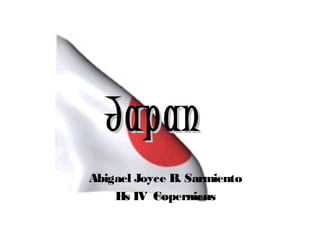Japan
- 1. Japan Abigael Joyce B. Sarmiento Hs IV Copernicus
- 3. Japanese
- 4. ? Japanese adapted to catering to authority and to harmonize with others. ? Japan is a country poor in natural resources but rich in hard-working and diligent people. ? they have more interest in human feelings and emotions than scientific or logical concerns. In terms of book read, literary books rate more highly than scientific books, compared with westerners. ? They tend to place themselves in their own exclusive and closed communities.
- 5. ? Japan has a population of about half of the United States with a land area about 90% of the state of California. ? They tend to pay attention to precise details rather than the big picture. ? They are better at developping transistors than space development projects. Mini- component audio systems are essential in their narrow houses often referred to "rabbit hutches". ? Country first and technology wise
- 6. Language Nihongo is a?language?spoken by over 120?million?people in? Japan?and in Japanese immigrant communities. It is a member of the?Japonic?(or Japanese-Ryukyuan) language family, which has a number of proposed relationships with other languages, none of which has gained wide acceptance amonghistorical linguists.
- 7. Flag ? The circle in the middle of the flag represents the sun. Japan's name translates to "The land of the rising sun." The white represents honesty and purity and the red disc is a sun symbol meaning brightness, sincerity and warmth.
- 8. Food Sushi Ramen Shabu-shabu Sashimi
- 9. Clothes ? K ono is a Japanese im traditional garment worn by men, women and children. The word "kimono", which literally means a "thing to wear" (ki?"wear" and?mono?"thing"),[2]?has come to denote these full- length robes. The standard plural of the word kimono in English is?kimonos,[3]?but the unmarked Japanese
- 10. Arts ? Ikebana?( ╔·╗© ?)?is the Japanese art of flower arrangement. It has gained widespread international fame for its focus on harmony, color use, rhythm, and elegantly simple design. It is an art centered greatly on expressing the seasons, and is meant to act as a symbol to something greater than the flower itself.
- 11. Festival
- 13. ? Ichigenkin?(kanji:? ę╗ĮLŪ┘) - one-string zither ? Koto?( Ū┘,? ╣~) - long zither ? Junanagen?( ╩«Ų▀ĮL) - 17-stringed zither ? Taishogoto?( ┤¾š²Ū┘) - zither with metal strings and keys ? Kugo?( ¾Ē¾¾) - an angled harp used in ancient times and recently revived ? Sanshin?( ╚²ŠĆ) - three-string banjo from Okinawa ? Shamisen?( ╚²╬ČŠĆ) - A banjo-like lute with three strings, the shamisen was brought to Japan from China in the 16th century. Popular in Edo's pleasure districts, the shamisen was often used in Kabuki theater. Made from red sandalwood and ranging from 1.1 to 1.4 meters long, the shamisen has ivory pegs, strings made from twisted silk, and a belly covered in cat or dog skin. The strings, which are of different thickness, are plucked or struck with a tortoise shell pick. ? Yamatogoto?( ┤¾║═Ū┘) - ancient long zither; also called?wa g o n?( ║═Ū┘ ) ? Tonkori?( ź╚ź¾ź│źĻ ) - plucked instrument used by









![Clothes
? K ono is a Japanese
im
traditional garment worn
by men, women and
children. The word
"kimono", which literally
means a "thing to wear"
(ki?"wear"
and?mono?"thing"),[2]?has
come to denote these full-
length robes. The
standard plural of the
word kimono in English
is?kimonos,[3]?but the
unmarked Japanese](https://image.slidesharecdn.com/electiveartssarmiento-121223214414-phpapp01/85/Japan-9-320.jpg)



